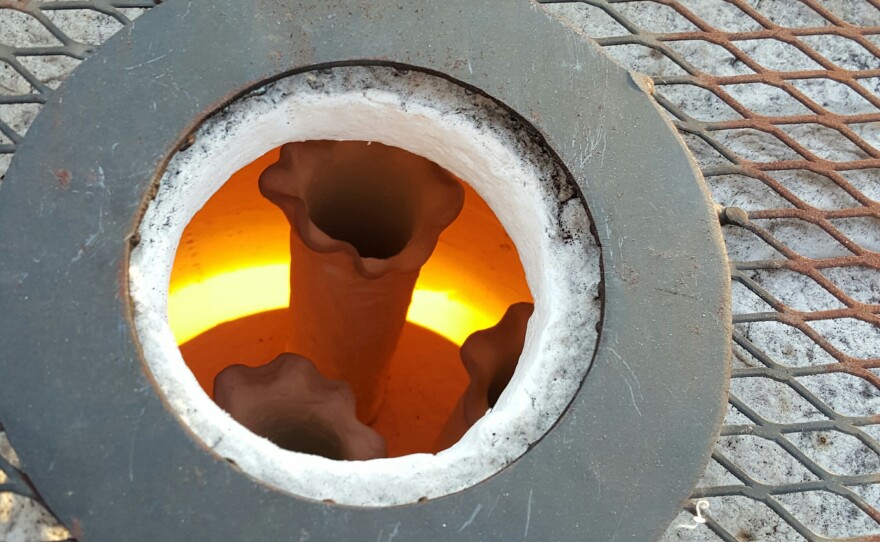This quarter the KSMU Sense of Community series is looking at "why we give," introducing you to people who are doing good deeds that help those who need it most. When Leslie Forrester of the Springfield Regional Arts Council told me about a pair of retired art teachers--one of whom you're about to meet--I knew they'd be a natural for the SoC series, based on what they've been doing, and for whom they've done it. Also, the fact that they're promoting the arts at the same time intrigued me.
I'm talking about Ann Kynion and Linda Griffin. Ann taught art at Willard for nearly 30 years, and Linda finished her art teaching career at Glendale High School after teaching at Hickory Hills and Fordland. They call their joint project "H O P E": "Helping Others With Positive Energy." Ann is out of the country (in Australia, actually) for the holidays, so I asked Linda to tell their story.
She and Ann both retired from teaching art in 2010, and together started holding Studio Day once a week. Says Linda, "On the first day of school for the 2010-11 school year, a friend of mine and I went to the river to float. And on the way there I thought, 'I want to give back to the community.' So I started thinking about how I can do that, and incorporate my art and giving?"
Linda's idea was "Hope Vases"--a project whereby she and her friend Ann Kynion would create flower vases to, as their business card says, "brighten the lives of people and to inspire hope and joy." Linda called her husband and told him she had come up with this "great idea--I want to do this!" And he replied, "How are you gonna fund it?!" (Which, of course, is the first question everyone has to ask when beginning an artistic endeavor!) Linda laughs at the memory. "I said, 'I don't know--but I think it can work!' And I called Ann over the phone on the way back home and I said, 'What do you think?'" Luckily Ann didn't take much (if any) convincing: she immediately said "I'm in! I think it's a great idea."
Linda continues, "When we started brainstorming about it, we really wanted to promote the arts, but also to promote (the idea to) other artists and students, to give back to the community." Their first thought when it came to recipients was, "we should definitely give them out to the cancer units at Mercy and Cox. So that's the way we started. And then we went to state (teachers') conferences and presented (the idea) to other art teachers to try to get them to encourage their students to do a project every year to give back to the community in some way or other."
Linda and Ann eventually realized they could use all the help they could get: for the first couple of years they took it upon themselves to deliver 12 vases every month--and it got to be too much for the two of them. Raku-fired vases, explains Linda, are a "time-consuming process because we roll out the clay; make the 'slab-built' vases, and then we have to dry it fire it, and then glaze it and raku fire it. And then we have to put flowers in them." At first they delivered vases full of fresh flowers, but were told by the hospital oncology units that many cancer patients are also dealing with auto-immune disorders of various kinds, and require artificial flowers instead of the real thing.
Linda says the vases vary in height, but basically she and Ann have come up with their own semi-automated production process, as she mentioned above: it's called "slab-building." Linda's husband bought her a commercial slab roller--no more rolling the clay out with rolling pins! "And then we wrap (the rolled-out clay) around a PVC pipe and start it that way. We don't wheel-throw them. We put designs in it, and we also stamp the word "H O P E" in each vase. Then we send a positive message with a card on the vase also."
There's a slide show illustrating the vase-making process (that's Linda's husband you see in the pictures) accompanying this story.
Among the groups to whom Ann and Linda reached out to try to interest them in similar projects were Kevin Kloppenburg's special-needs art class at Central High School (who produced vases to give away), and a home-school program, where they taught the teachers and students how to make vases--which, says Linda Griffin, "allowed them to give to somebody who needed hope."
In their main mission of distributing Hope Vases to local cancer patients, Linda Griffin and Ann Kynion leave it up to the nursing staffs at Mercy's Chub O'Reilly and Cox's Hulston Cancer Centers to decide how the vases are to be given out. Linda says they give the vases to the head nurses "and we ask them to distribute them to someone who might need a little extra hope in their life." I asked if they deliver any vases personally, and Linda said, "we have given them out to people that we know personally that need a Hope Vase. I recently gave one to a person I work with at Delaware School who was undergoing some cancer treatment. But typically, I would rather the nurses get to do it."
They have definitely heard from grateful recipients, says Linda. "We have a blog (http://hopevases.wordpress.com) that people have sent in messages. And we've received a few cards from people saying that it really meant a lot to them to get this Hope Vase."
For more information about the Hope Vases Project, contact Linda Griffin at lingriffin@mchsi.com or (417) 693-8334, or click on the link to their blog page above. While Ann Kynion is out of the country, you can contact her by email at akynion@mediacombb.net.







